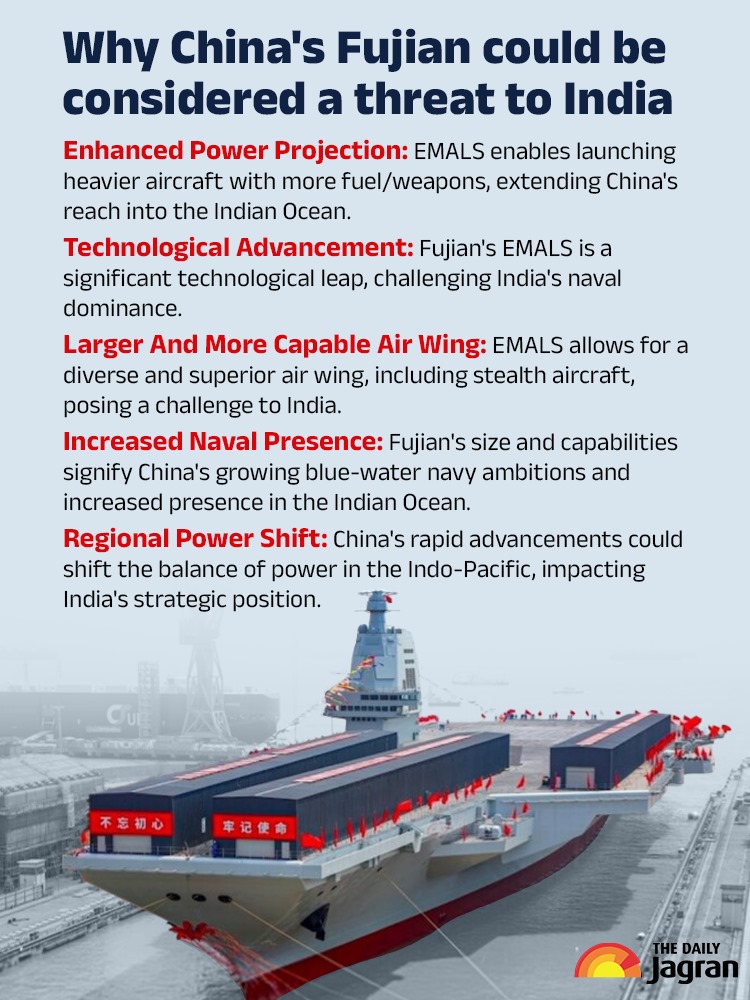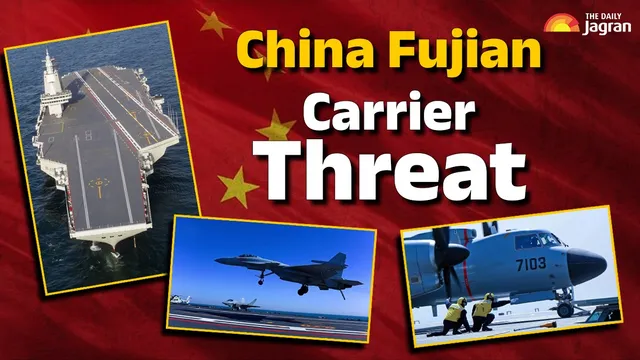- By Ajeet Kumar
- Fri, 07 Nov 2025 02:21 PM (IST)
- Source:JND
Chinese Media on Friday reported that the country had commissioned its third aircraft carrier, the electromagnetic catapults-equipped Fujian. With this launch, China has three aircraft carriers.
Chinese President Xi Jinping attended the commissioning and flag-presenting ceremony of the Fujian on Wednesday, according to the Xinhua News Agency. Xi boarded the aircraft carrier to inspect the vessel at a naval port in Sanya City, according to Xinhua.
The Fujian was launched in June 2022 and named after Fujian Province.

What is aircraft carrier?
An aircraft carrier is a warship that serves as a mobile, seaborne airbase, featuring a full-length flight deck and hangar facilities to support and launch aircraft. These large vessels allow a navy to project air power globally without relying on land-based airfields and are considered the capital ship of a naval fleet.
🚨🇨🇳 China commissions its third aircraft carrier 'Fujian'
— Sputnik India (@Sputnik_India) November 7, 2025
It's the first ship in China's fleet to feature an electromagnetic catapult system for aircraft launches.
President Xi Jinping attended the ceremony and inspected the new vessel. pic.twitter.com/Aye6SGHCR6
Fujian is a symbol of the achievements
According to Chinese Media, the commissioning of the Fujian is a symbol of the achievements in the transformation of the PLA Navy from coastal defence to far seas defence, marking that China has officially entered an era with three aircraft carriers, as well as an era of electromagnetic catapult-equipped carrier.
The use of the electromagnetic catapult system enables aircraft to take off with full fuel and ammunition, increasing the combat radius and enhancing the attack capability; it also allows for a significant increase of aircraft carrier sortie rate.
Fujian: Key features
On September 22, the PLA Navy announced that the Fujian had achieved a breakthrough by hosting the first catapult-assisted takeoff and arrested landing training for the J-15T heavy fighter jet, the J-35 stealth fighter jet, and the KJ-600 early warning aircraft.
These aircraft, along with the J-15DT carrier-borne electronic warfare aircraft, were also featured in China's V-Day military parade held in Beijing on September 3, reported the Global Times.
ALSO READ: China's 4th Aircraft Carrier Under Construction: Could It Threaten US Naval Power? 5 Key Points
With a full-load displacement of more than 80,000 tons, the carrier is equipped with electromagnetic catapults and arresting devices.
Since its first sea trials in May 2024, the Fujian has carried out a series of maritime tests according to plan, progressing with equipment commissioning and assessments of overall operational stability, reported Global Times.
Why is it concerning for India?
1. The Fujian, with its advanced electromagnetic catapult system (EMALS), allows China to launch heavier and larger fixed-wing aircraft with greater fuel and weapons loads. This significantly extends China's naval aviation operational range and capability, enabling them to project power further into the Indian Ocean Region, which is strategically important to India.
2. The Fujian is only the second carrier in the world, after the US' Gerald Ford-class ships, to feature an EMALS. This represents a significant technological leap for China, moving past conventional steam-powered catapults and demonstrating a sophisticated capability that could challenge India's naval dominance in the region.
ALSO READ: China Releases New Images Of Its Next-Generation Aircraft Carrier Fujian; Awaits Sea Trials
3. The electromagnetic catapults enable faster take-offs and allow the Fujian to deploy a more diverse and capable air wing, including stealth aircraft like the J-35 and early warning aircraft like the KJ-600. This superior air power could pose a significant challenge to India's existing naval air capabilities.
4. The commissioning of the Fujian, which is much larger than China's previous carriers (displacing roughly 80,000 tonnes compared to Liaoning's 60,000 and Shandong's 66,000), signifies China's growing ambition for a blue-water navy. This increased naval presence in the Indian Ocean could lead to heightened tensions and competition for influence.
5. The Fujian's advanced capabilities contribute to a broader carrier buildup among regional powers. While India is also bolstering its naval projection, China's rapid advancements could shift the balance of power in the Indo-Pacific, potentially impacting India's strategic position and security interests.
(With inputs from agency)

